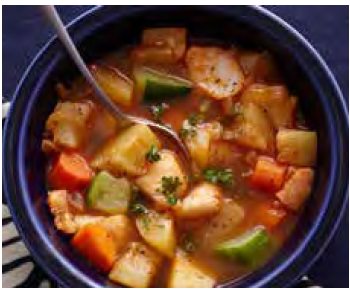Types, Advantages, Disadvantages - Moist Heat Cooking Method | 11th Nutrition and Dietetics : Chapter 1 : Introduction to Food
Chapter: 11th Nutrition and Dietetics : Chapter 1 : Introduction to Food
Moist Heat Cooking Method
MOIST HEAT METHOD
In this method, food
comes in contact with moisture either by water or steam under pressure. Some
common ways of cooking food by moist heat are described below.

1. Boiling
Boiling is cooking
foods in a liquid (water, bouillon, stock, milk) at boiling point. Boiling is a
method of cooking foods by just immersing them in water at 100 ºC and
maintaining water at the temperature till food is tender. Rice, egg, dhal,
meat, roots and tubers are cooked by boiling method.

Advantages
·
Boiling is a safe and simple method of cooking.
·
It is suitable for large scale cooking. Boiled food is also
digested easily
Disadvantages
·
While boiling, water soluble nutrients are lost if the water in
which the food is boiled is discarded. Some people may not like boiled food as
they find it bland.
2. Stewing
When food is cooked
with the heat from water vapors, it is called stewing. This method requires the
food to be cooked in steam. Stewing is a long and slow cooking method where
food is cut into pieces and cooked in the minimum amount of liquid, water,
stock or sauce. The food and the cooking liquid are served together. In this
slow method of cooking the liquid is heated to boiling point and heat is
reduced to maintain simmering temperatures (820 ºC – 900 ºC).

Advantages
·
In stewing, the juices of the food are retained and the food
tastes good.
·
The nutrients are also conserved better.
Disadvantages
·
Food takes longer to cook.
·
The process is time consuming and there is wastage of fuel.
3. Steaming:
It is a method of cooking
food in steam generated vigorously from boiling water in a pan. The food to be
steamed is placed in a container and is not in direct contact with the water or
liquid. Idli, custard and idiappam are made by steaming. Vegetables can also be
steamed.

Advantages
·
Steaming shortens the duration of cooking and helps to conserve
·
nutritive value, colour, flavour and palatability of food.
·
Steamed food is light, nutritious and easy to digest. Such foods
are good, especially for people who are sick or people with weak digestion or
for the elderly. Young children can be served with steamed food.
Disadvantages
·
Steaming equipment is required.
·
This method is limited to the preparation of selected foods.
4. Pressure cooking :
When steam under
pressure is used, the method is known as pressure cooking and the equipment
used is the pressure cooker. In this method the temperature of boiling water
can be raised above 100 ºC. Rice, meat, roots and tubers are usually pressure
cooked.

Advantages
·
Pressure cooking kills all bacteria and hence the food is safe
and hygienic to eat.
·
The food gets cooked faster i.e. almost 1/3rd time
than boiling.
·
Saves fuel, time and energy.
·
Several foods can be cooked together in the pressure cooker by
using separators.
·
It is not necessary to immerse food in water while cooking and
this reduces the loss of water soluble vitamins and minerals.
Disadvantages
·
If food is cooked for very long, it loses its texture and may
even burn.
·
Knowledge of the usage, care and maintenance of cooker is
required to prevent accidents.
·
Careful watch on the cooking time is required to prevent over
cooking.
5. Poaching:
This involves cooking
in minimum amount of liquid at temperatures of 800°C – 850°C that is below the
boiling point. Foods generally poached are egg, fish and fruits. For poaching
eggs, the addition of little salt or vinegar to the cooking liquid lowers
temperature of coagulation. Eggs get cooked quickly by poaching.

Advantages
·
A variety of liquids can be used (stock, wine, milk, syrup).
·
Liquid can improve flavor.
·
Food becomes more digestible.
·
Ideal for high-protein foods, eg. Fish
Disadvantages
·
Requires constant attention.
·
Range of suitable foods is limited.
·
Foods overcook quickly.
6. Blanching:
In meal preparation,
it is often necessary only to peel off the skin of fruits and vegetables
without making them tender. This can be achieved by blanching. eg. tomatoes can
be blanched in this method, food is dipped in boiling water for 5 seconds to 2
minutes depending on the texture of the food. This helps to remove the skin or
peel without softening food.

Advantages
·
Peels can easily be removed to improve digestibility.
·
Destroys enzymes that bring about spoilage.
·
Texture can be maintained while improving the colour and flavour
of food.
Disadvantage
·
Loss of nutrients if cooking water is discarded.
Related Topics